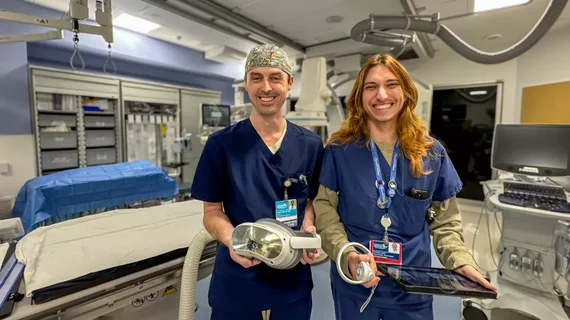Hospital creates 'virtual reality technologist' role to support patients during interventional procedures
The interventional radiology team at Children’s Hospital Los Angeles is tapping into virtual reality technology to reduce the need for sedation during procedures.
Phoenix Hunt serves as the hospital’s first embedded VR technologist. Hunt, who studied virtual reality game design at Savannah College of Art and Design, helps support patients during IR procedures by guiding them through procedure-specific VR games designed to ease anxiety and discomfort. In turn, procedures can often be completed in less time and without the use of sedation.
“In most healthcare contexts, VR has been used to support patients as a relaxation tool,” Joseph Miller, MD, Director of Interventional Radiology, said in a news release about the new role. “We’re applying these same types of technologies to pediatrics in a novel way to minimize anxiety, pain, and discomfort and even reduce anesthesia use.”
Miller noted that many children who are nervous about IR procedures often need some form of sedation. This requires limiting their food intake for up to 12 hours, plus additional time—usually several hours—to completely come out of sedation.
“That’s a lot logistically for the patient—and for their family and care team—for what is ultimately a five-minute procedure,” he noted. “Our goal is to reduce that footprint for everybody.”
Miller said that the VR technology has been available to the hospital for a while, but that they lacked the right person to integrate it. That’s how the VR technologist position came about.
The technologist introduces patients to the VR option prior to their procedure, showing them the different game options they can play and giving a demonstration prior to the actual procedure. Hunt remains with the patient throughout the duration, collaborating with the IR team to monitor vitals, pain levels and anxiety during and after.
“At the end, I ask them if they’d want to do this again, and if they preferred it to anesthesia,” Hunt said. “So far, across the board, everyone has had overwhelmingly positive feedback.”
Given the VR program's early success, the team is hoping to expand its use throughout the hospital.
“We’re exploring all of the ways VR can be used across departments and patient populations,” Miller said. “It's not just for us, or even just for our patients—creating additional resources to reduce the work burden on healthcare team members is a huge deal.”
Learn more about the VR program here.

